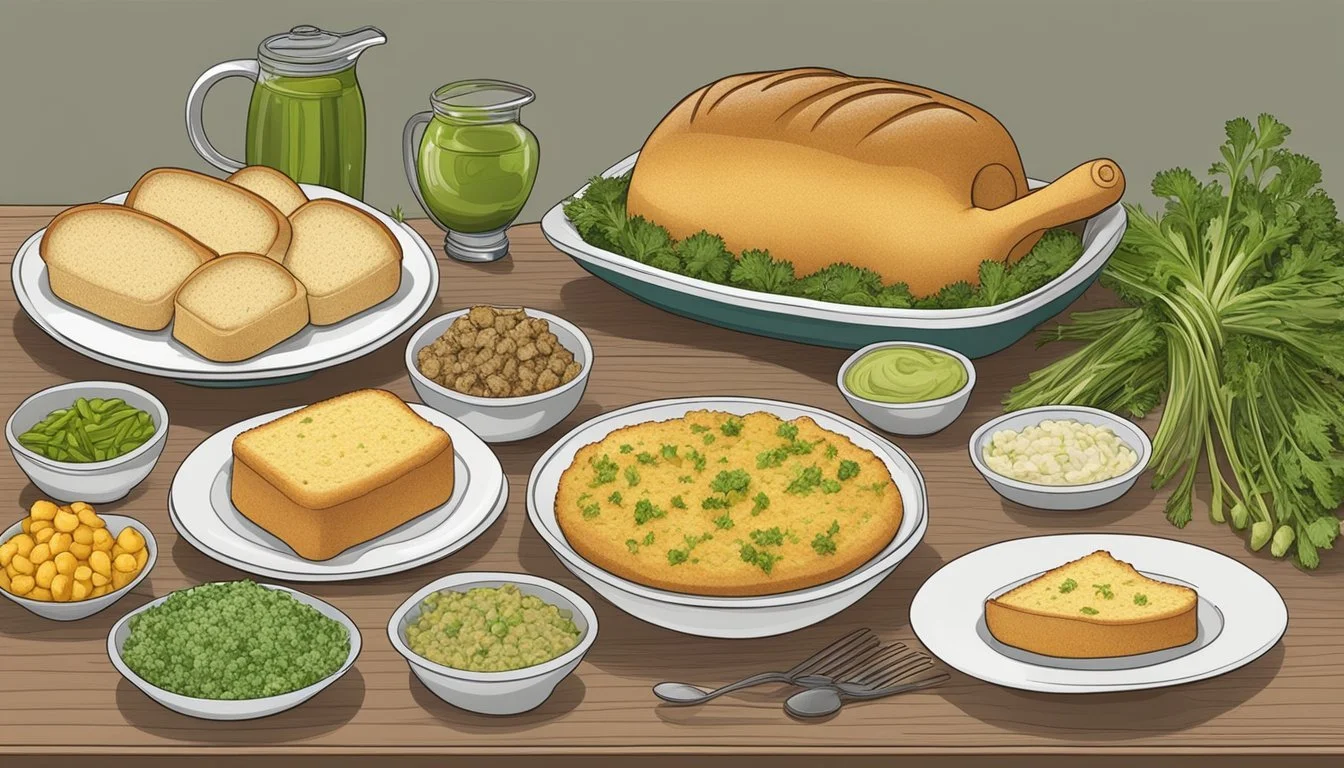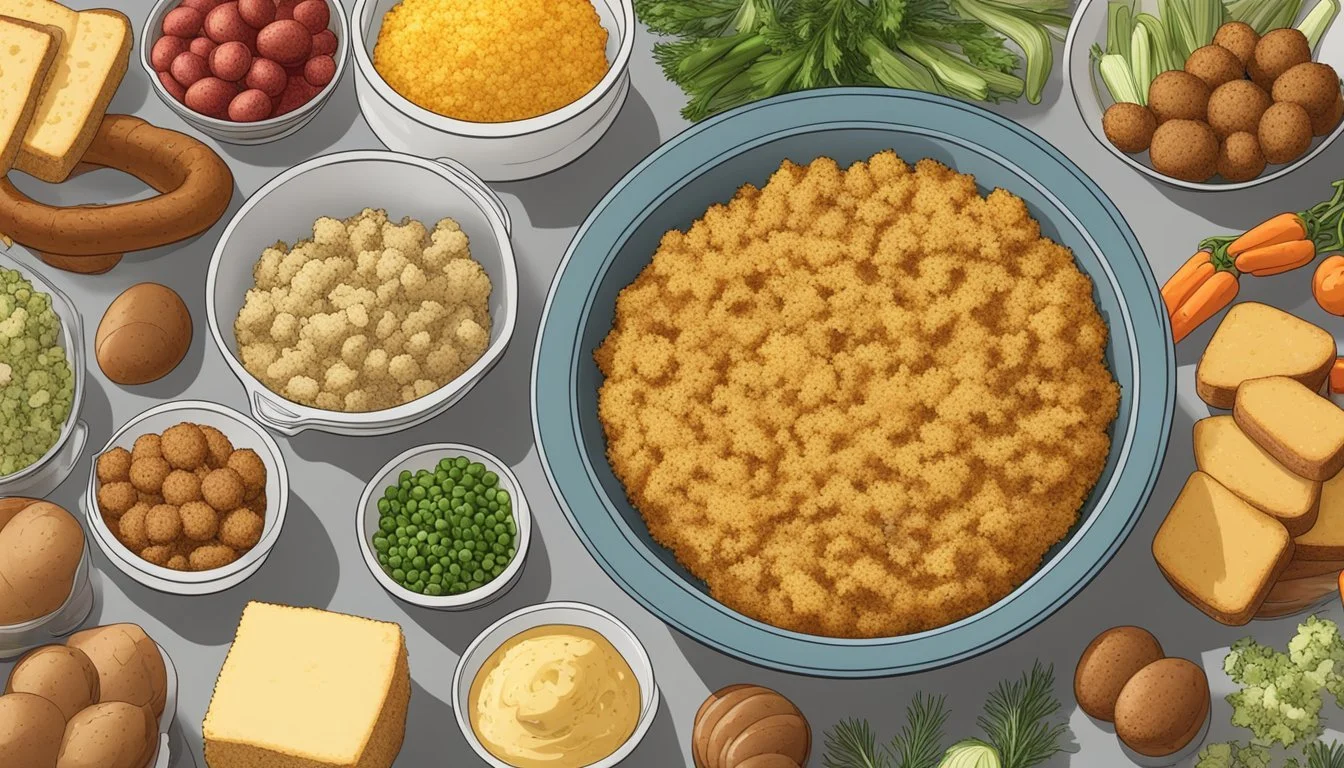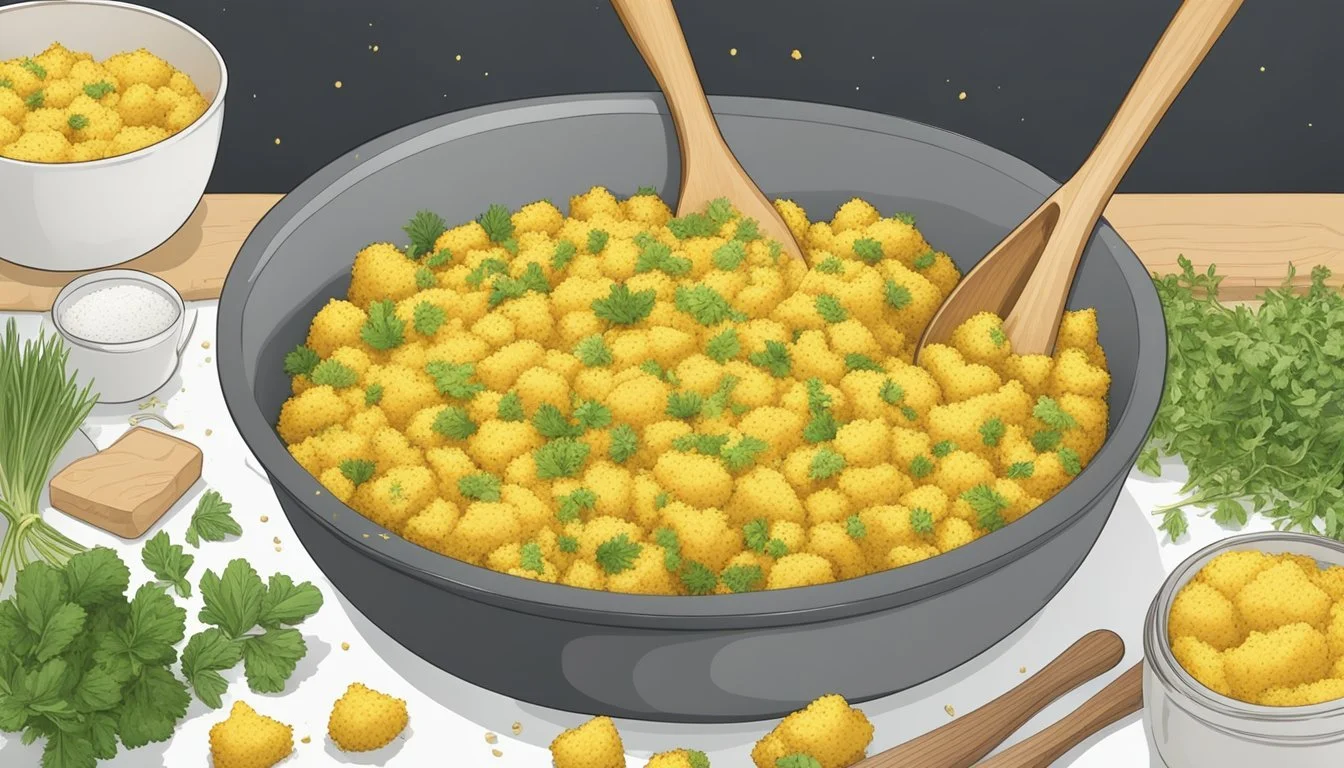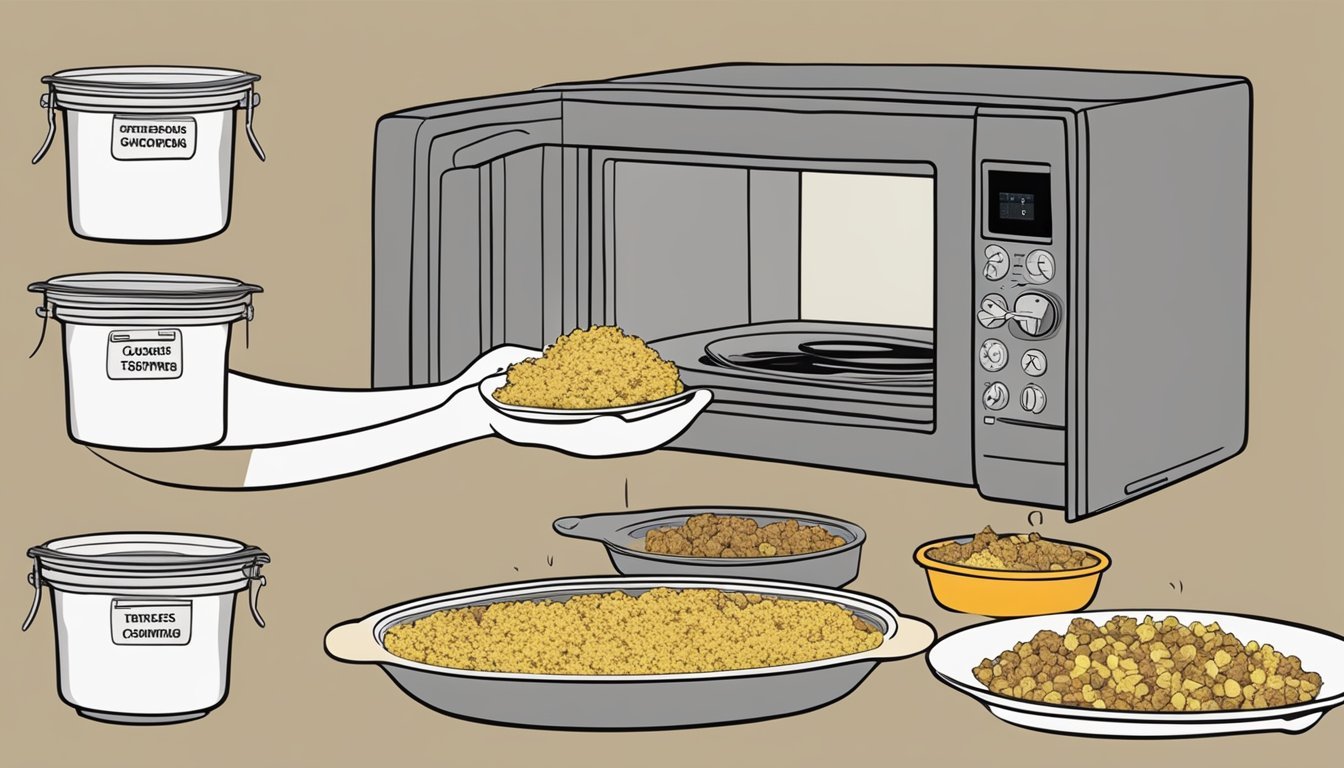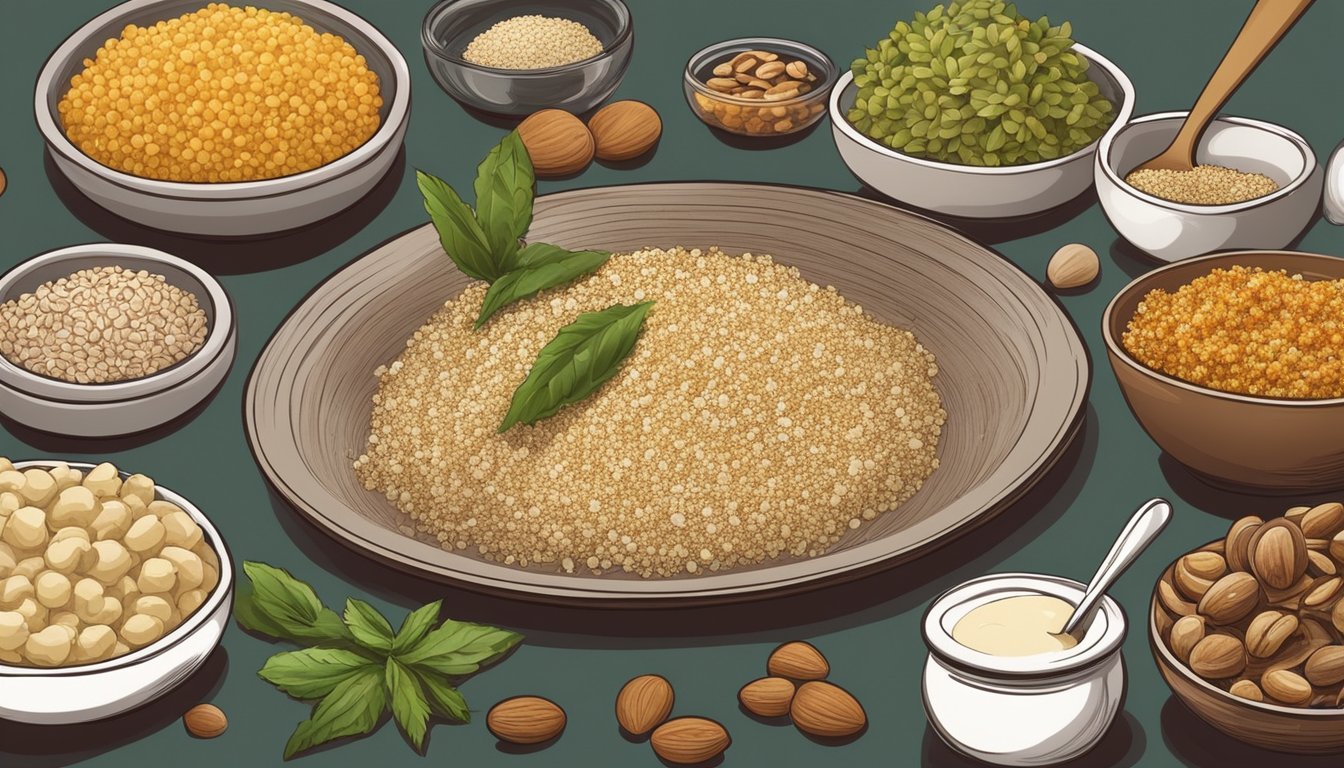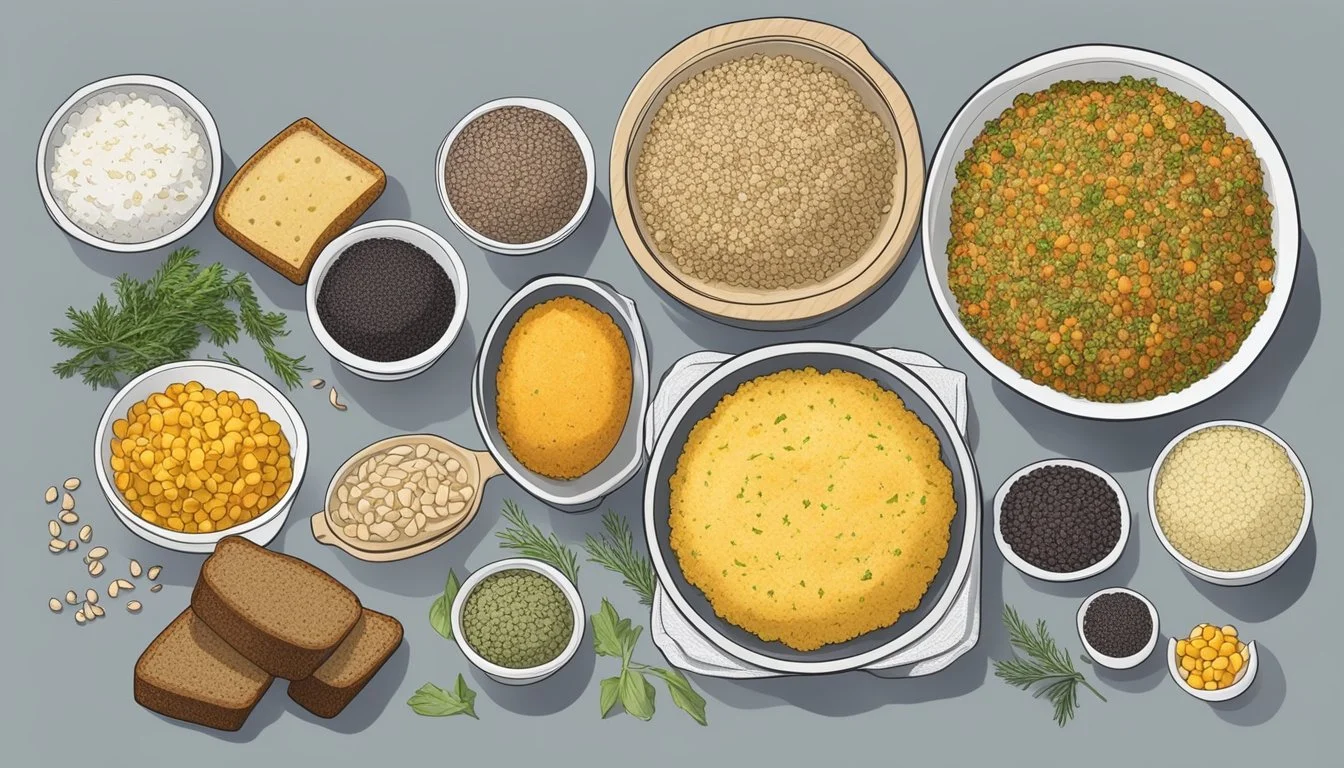Cornbread Stuffing Substitutes
Top Alternatives for Your Recipes
Looking for cornbread stuffing substitutes that can elevate your Thanksgiving side dish? When you need a gluten-free or vegan option for your homemade cornbread stuffing, there are plenty of creative and delicious alternatives to try. Breadcrumbs make an excellent replacement, delivering a similar crispy texture and flavor.
For those who prefer classic Southern dishes, starting with gluten-free cornbread can produce a stuffing that rivals any traditional bread counterpart. Incorporating ingredients like fruit, nuts, mushrooms, or rich sausage can add a delightful twist to your stuffing. Exploring these substitutes can help cater to diverse dietary preferences while maintaining the delicious, comforting essence of your Thanksgiving meal.
Understanding Cornbread Stuffing
Cornbread stuffing is a versatile dish often served as a Thanksgiving side dish. It typically includes cornbread, sage, onion, and celery, among other ingredients, resulting in a range of rich and savory flavors.
Historical Significance
Cornbread stuffing has roots in Southern cuisine, closely tied to Native American traditions, where cornbread played a crucial role. European settlers adopted and adapted these practices, combining local ingredients with their own culinary techniques. Over time, cornbread stuffing became a Thanksgiving staple, symbolizing cultural fusion and culinary history.
The dish's evolution also reflects regional preferences, with variations including oysters, chestnuts, or pecans, making it adaptable yet traditionally significant during holiday feasts.
Key Ingredients
The primary ingredient is homemade cornbread, which provides a distinctive texture and flavor. Commonly, cornmeal, flour, butter, sugar, and milk are used to bake the cornbread.
Typical stuffing ingredients include onion, celery, and sage. Sausage is often added for extra flavor, while herbs like thyme and parsley enhance the dish. Eggs are crucial as they bind the mixture together.
Traditional Flavors
Cornbread stuffing boasts a robust and earthy flavor profile. Cornbread’s natural sweetness pairs well with the savory elements of sausage and vegetables. Herbs like sage and thyme deliver a fragrant and slightly peppery taste, whereas celery and onions add crunch and subtle sweetness.
Butter in the mix ensures richness, creating a comforting dish. The balance of these ingredients highlights why the dish remains beloved in holiday traditions.
Cornbread Varieties
Cornbread comes in various forms that cater to different taste preferences, predominantly divided into sweet and savory types. Each version has distinct ingredients and flavor profiles, making them versatile for various culinary needs.
Sweet Cornbread
Sweet cornbread is often characterized by its rich and moist texture. This variety typically includes yellow cornmeal, flour, baking powder, and sugar.
Honey or buttermilk can also be added to enhance sweetness and moisture. Sweet cornbread pairs well with savory dishes like chili or barbecue, balancing the strong flavors with its mild sweetness.
Ingredients:
Yellow cornmeal for its lightly sweet flavor
Sugar or honey for extra sweetness
Buttermilk to add moisture and a slight tang
The baking process uses a combination of baking powder to ensure a light, fluffy texture.
Savory Cornbread
Savory cornbread lacks the added sugars found in its sweet counterpart, focusing instead on a more robust, hearty flavor profile. It's often made with buttermilk, flour, yellow cornmeal, and baking powder.
Sometimes, additional elements like cheese, chiles, or herbs are included to intensify the savoriness.
Ingredients:
Yellow cornmeal for a classic cornbread base
Minimal to no sugar to keep it savory
Buttermilk for moisture and a subtle tang
Optional Add-ins:
Cheese for a salty kick
Chiles for a hint of spice
Herbs to add complexity
Savory cornbread is ideal for stuffing recipes or as a side for soups and stews.
Substitutions for Cornbread Stuffing
For those looking to substitute cornbread stuffing, there are both bread alternatives and gluten-free options available. Each substitute brings unique flavors and textures suitable for various dietary needs and preferences.
Bread Alternatives
Certain bread types can make excellent substitutes for cornbread stuffing. Sourdough bread offers a tangy flavor and hearty texture. Slice it into cubes and toast it until it's dry for the best results.
French bread is another viable option. Its dense, chewy crumb pairs well with herbs and vegetables. Ensure the bread is slightly stale before using.
Rye bread delivers a distinct flavor, especially when combined with caraway seeds. This type is perfect for those who prefer a more robust taste.
For a vegetarian stuffing, incorporate whole grain bread. Its nutty flavor complements vegetables and broths excellently.
Gluten-Free Options
For gluten-free alternatives, gluten-free breadcrumbs can replace traditional ones. They mimic the texture of cornbread stuffing when combined with broth and seasonings.
Riced cauliflower gives a grain-like texture without gluten. It's particularly light and absorbs flavors well.
Quinoa is another great option. Cook it beforehand, then mix with your usual stuffing ingredients.
Gluten-free cornbread can mimic the original stuffing closely. It’s essential that the cornbread itself is prepared using gluten-free flour blends to maintain texture.
By selecting appropriate substitutes, one can easily replicate the delicious texture and flavor of traditional cornbread stuffing.
Additional Ingredients and Variations
Adding different ingredients to cornbread stuffing can enhance its flavor and texture. Below are some ideas for incorporating meats, vegetables, fruits, nuts, dairy, and fats to create a unique and delicious stuffing.
Meats and Proteins
Sausage is a popular addition that infuses the stuffing with a savory and slightly spicy flavor. Adding cooked sausage crumbles or slices, either regular or spicy Italian, can elevate the dish.
For a protein-packed option, consider bacon. Crisp, cooked bacon pieces provide a smoky taste that complements the cornbread's sweetness.
Ground beef or turkey are also excellent choices, providing a hearty base. For a richer flavor, eggs can be mixed into the stuffing, binding the ingredients together.
Vegetables and Herbs
Vegetables like onions, celery, and mushrooms add essential texture and moisture. Sauté these in unsalted butter until soft before mixing them into the stuffing.
For an aromatic boost, fresh herbs such as sage, thyme, and rosemary contribute a fragrant complexity.
Carrots can be added for a bit of sweetness and color while being true to traditional stuffing ingredients. Poultry seasoning is another blend that adds a balanced herbal note.
Fruits and Nuts
Incorporating pecans or walnuts introduces a crunchy texture and a nutty flavor that pairs well with the cornbread base. These nuts can be toasted beforehand to enhance their flavor.
Dried fruits, such as cranberries, apricots, or raisins, add a sweet and tart contrast. Fresh fruits, such as chopped apples or pears, can also be used to infuse sweetness and moisture into the stuffing.
Dairy and Fat Options
The choice of fat is crucial. Butter—especially buttery, unsalted butter—is the classic choice, providing a rich taste.
Substituting butter with olive oil can offer a lighter, healthier option. Cheese, such as shredded cheddar or parmesan, can be stirred in for a creamy, melty component.
Adding cream or milk enriches the stuffing’s overall texture, making it soft and cohesive. These dairy components can also help in binding all the ingredients together similarly to eggs.
Preparing the Stuffing
Preparing cornbread stuffing involves managing cook time and temperature, making ahead if needed, and using proper mixing and baking techniques to ensure a delicious result. Proper preparation yields a moist and flavorful dish.
Cook Time and Temperature
Cook the stuffing at 375°F for optimal results. This temperature allows for even baking and a crisp top layer. Total cook time ranges from 30 to 40 minutes, depending on your oven and the moistness of the ingredients.
Using a non-stick baking dish ensures easy removal and cleanup. Cover the dish with foil for the first half of baking to retain moisture. Remove the foil for the final 15 minutes to brown the top. Always check for doneness by ensuring the internal temperature reaches 165°F.
Make-Ahead Tips
Making stuffing ahead of time can save prep time on busy days. Prepare the stuffing mix and store it in an airtight container in the refrigerator up to 24 hours before baking. Avoid adding eggs until just before baking to maintain texture.
Freezing is another make-ahead option. Freeze the unbaked stuffing in a baking dish wrapped tightly in foil. Thaw in the refrigerator overnight before baking as directed. This method helps in retaining the dish’s flavor and moist texture.
Mixing and Baking Techniques
Start with a large bowl for mixing. Combine the cornbread cubes with sautéed onions, celery, and unsalted butter for flavor. Add cooked ingredients gradually, ensuring even distribution. Lightly whisk the eggs and combine them with chicken broth or vegetable broth before adding.
Fold all ingredients gently to avoid breaking the cornbread cubes. Fresh thyme leaves and other herbs like sage add aroma. Place the mixture into the prepared baking dish and distribute evenly.
For a crunchy texture, spread the mixture to the edges of the baking dish. Avoid packing too tightly. Baking the dish partially covered ensures it retains moisture while developing a nice crust for a satisfying texture.
Storage and Reheating Instructions
Properly storing and reheating cornbread stuffing can ensure it remains flavorful and safe to eat. Follow these detailed instructions for refrigerating, freezing, and reheating.
Refrigerating Leftovers
Store cornbread stuffing in an airtight container to maintain freshness. Place the container in the refrigerator within two hours of cooking.
Leftover stuffing is safe to eat for up to 3-4 days.
Tip: Before refrigerating, you may want to portion the stuffing into individual servings. This makes reheating easier and quicker, especially for busy days after Thanksgiving.
Freezing Advice
Cornbread stuffing freezes well, allowing for long-term storage. Wrap the stuffing tightly in plastic wrap or aluminum foil and place it in a freezer-safe bag or airtight container. Label the container with the date.
Frozen stuffing retains quality for up to 2-3 months.
Before reheating, allow the stuffing to thaw overnight in the refrigerator. Thawing ensures even heating and prevents cold spots.
Reheating Tips
To reheat in the oven, preheat to 350°F (180°C). Transfer the stuffing to an oven-safe casserole dish. Add a few tablespoons of broth for moisture. Cover with foil and heat for 15-30 minutes.
For stovetop reheating, place the stuffing in a skillet over medium heat. Moisten with broth and stir occasionally until it reaches 165°F (74°C).
In the microwave, mix melted butter or oil with broth (about 1 teaspoon per serving of butter and 1 tablespoon per serving of broth). Cover well and heat on high for 1-2 minutes, stir, and heat for another 1-2 minutes, if necessary.
Adjust the reheating method to fit the portion size, ensuring the stuffing is hot throughout without drying out.
Sharing and Presentation
Serving cornbread stuffing is a delightful experience when it's presented beautifully. Considerations for serving suggestions, appropriate food pairings, and photography tips for social media ahead can make a significant impact.
Serving Suggestions
When serving cornbread stuffing, think about portion size. For gatherings like Thanksgiving, a standard serving size is around 1/2 cup per person. For more formal presentations, use ramekins or mini baking dishes to create individual servings.
Arrange servings neatly on a large platter, garnish with fresh herbs like parsley or thyme for a pop of color. Provide serving utensils that make it easy to scoop and serve. A quality gravy boat nearby offers options for guests to enhance their portion.
Food Pairings
Cornbread stuffing pairs well with classic holiday dishes. Pair it with roasted turkey or chicken to bring out the stuffing's herbal and savory flavors.
Vegetarians will appreciate pairing it with grilled vegetables such as brussels sprouts or green beans, complemented by a light vinaigrette. For a Southern twist, consider fried okra or collard greens as sides.
Balance the meal with a cranberry sauce to add a sweet and tangy contrast. These side dish combinations not only complement the stuffing but also create a cohesive meal.
Photography Tips for Social Media
When photographing cornbread stuffing for social media platforms like Instagram or Pinterest, focus on lighting and angle. Natural light is best, so shoot near a window.
Aerial shots capture the dish's texture effectively. Use props such as cutlery, napkins, and herb sprigs to enhance the setting.
Highlight the stuffing's ingredients by adding extra pecans or chopped celery on top, making the dish visually appealing. Edit photos to enhance brightness and contrast but avoid filters that might alter the food's natural colors, ensuring the dish remains authentic and tantalizing.
Nutritional Considerations
When substituting ingredients in cornbread stuffing, it's important to be mindful of the nutritional changes that might occur. Substitute options can affect caloric content and dietary adjustments, catering to specific needs like gluten-free or dairy-free diets.
Caloric Content
Cornbread is relatively calorie-dense, with a standard 60-gram serving containing roughly 200 calories. Substituting ingredients can alter this count.
Butter substitutes like plant-based margarine can lower fat content. Non-dairy milk options may also change the overall calories slightly. Similarly, if using applesauce to replace eggs, note that it adds moisture without significantly increasing calories.
Reading labels of substitute ingredients and measuring portions carefully is key to managing caloric intake.
Dietary Adjustments
For those with specific dietary needs, substitutes play a crucial role. Gluten-free cornbread mixes are available for individuals with gluten intolerance or celiac disease. Such mixes often use rice flour or almond flour, thus keeping the stuffing gluten-free.
Dairy-free options like using almond milk instead of regular milk and plant-based margarine instead of butter ensure the stuffing caters to lactose-intolerant individuals. Substitutes attempt to maintain taste and texture.
Chia seeds or flaxseeds mixed with water can replace eggs for vegan or egg-allergy diets, keeping the stuffing suitable without compromising on nutrition.
Consider allergens and specific dietary restrictions when choosing to substitute traditional ingredients. Always verify labels and consult nutritional charts to meet individual dietary goals.


